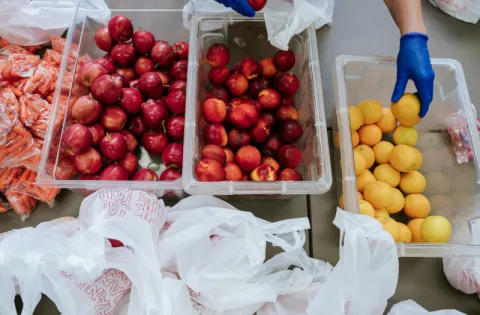What's the Difference Between a Food Bank and a Food Pantry?
Although many of No Kid Hungry's efforts are directed toward schools and community groups, we also support food banks - particularly during the first years of the COVID-19 pandemic. In our work with food banks nationwide, we have learned that not everyone understands the differences between a food bank and a food pantry - including the purpose of each, how each one functions and ways to contribute to both.
In this post, we've tried to explain the difference between food banks versus food pantries, making it easier to understand the vital role each one serves in your community.
What is a Food Bank?
Food banks are nonprofit facilities that store food to be delivered to various local food programs, including food pantries. Many food banks are enormous, some providing double the amount of space than an average wholesale club.
Food banks operate like warehouses, supplying food to facilities and programs that serve the community.
A food bank is used as a safe storage space for food donated by local individuals and families, grocery stores, retailers and restaurants. In addition to donations, some food banks procure food in bulk to provide to their pantry partners at a lower cost. Additionally, some stored food is supplied by government agencies like the USDA or The Emergency Food Assistance Program (TEFAP).
Generally, a food bank will hire drivers to deliver food to food pantries, school meal programs, and other designated locations within a specific area. For example, urban food banks have a "shopping floor" for pantry partners to pick up their own food orders and shop what is in season. In addition, many food banks operate as pickup sites for local partners.
Food banks may also offer additional services to the community.
In addition to supplying local programs, many food banks participate in community outreach efforts. For example, some may facilitate educational initiatives to end the cycle of poverty, improve quality of life, and empower individuals dealing with hunger.
Some programs that food banks may offer include:
- SNAP and WIC application assistance to help people access these federal nutrition assistance programs and grocery benefits.
- Food education classes that teach people how to cook healthy meals on a budget, how to stretch their food dollars, and other food-related topics.
- Workforce development resources, such as job search and training assistance and job placement.
- Free health screenings, such as blood pressure checks, to help people identify and address any health issues they may have.
- Summer meals and afterschool meal programs.
What is a Food Pantry?
A food pantry is an independent, often volunteer-run community space that provides families with food (which has been supplied by a food bank). It is not uncommon for food pantries to serve upwards of hundreds of people every week.
Food pantries take many forms to serve the people of a community directly.
Because the needs of every community are unique, there are many different kinds of food pantries.
For example:
- A food pantry may be situated inside a school so that children and their families can easily access food when needed.
- Faith-based organizations may set up food pantries at local places of worship, opening their doors to anyone in the area in need.
- Mobile food pantries are often ideal in communities with obstacles to accessibility, such as rural areas with limited transportation. For example, a mobile food pantry might deliver pre-packaged food boxes directly to homebound seniors, or it might offer pick-up stations in convenient locations where individuals can simply come by to get a box if needed.
In addition to fresh food items, food pantries provide non-perishable food items, such as canned goods, boxed/canned foods and meals, dried grains, cereals, nut butters, and condiments. In some locations, food pantries are also stocked with household supplies, such as personal care products, pet food, diapers, and baby formula. The ideal food pantry model would allow individuals to shop for what they need like they would at a grocery store.
Who can use a food pantry?
Some food pantries have no specific qualifications for individuals interested in using them and are open to all. Often, visitors are not asked to provide proof of income or identification. Other types of pantries may require that visitors meet certain income qualifications, such as those that state Emergency Assistance Food Programs fund.
In some cases, visitors may be asked their zip code and/or the number of people in their household, primarily for record-keeping purposes. Some food pantries ask that visitors show some form of ID solely to confirm that they are community residents.
Help Your Local Community by Donating to No Kid Hungry
If you want to help families in your community, No Kid Hungry is a nonprofit campaign that can use your donation to support local groups working to feed children. Thanks to generous one-time and monthly donations from individuals, families, and businesses/organizations, we can consistently work toward ending childhood hunger in the U.S.
If you’d like to learn more about starting a food pantry in your community, then be sure to download our free PDF, which contains everything you need to know to set up and run a successful school food pantry.
Make a donation, start fundraising for hungry kids, or find other ways to get involved today!
Image Credits: Ground Picture / Shutterstock



